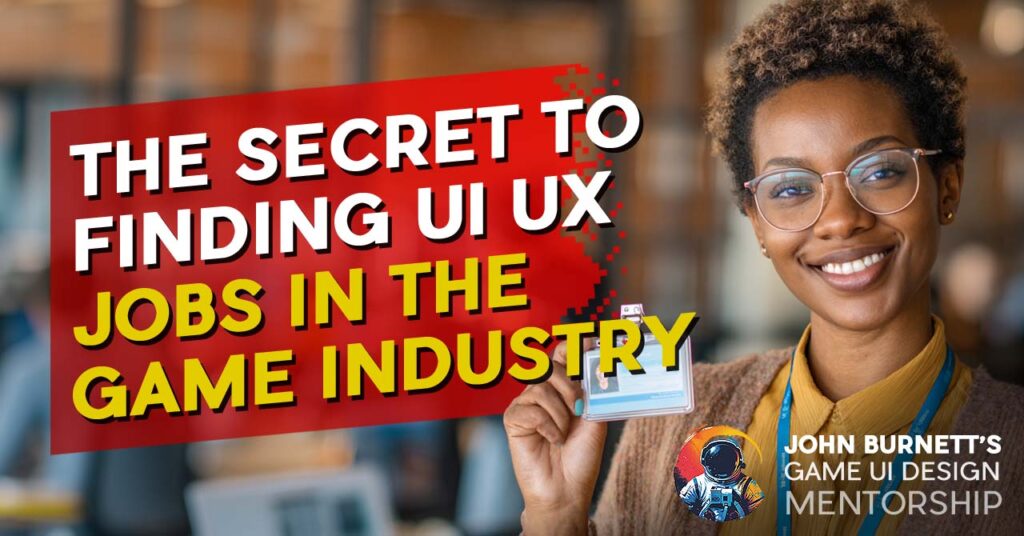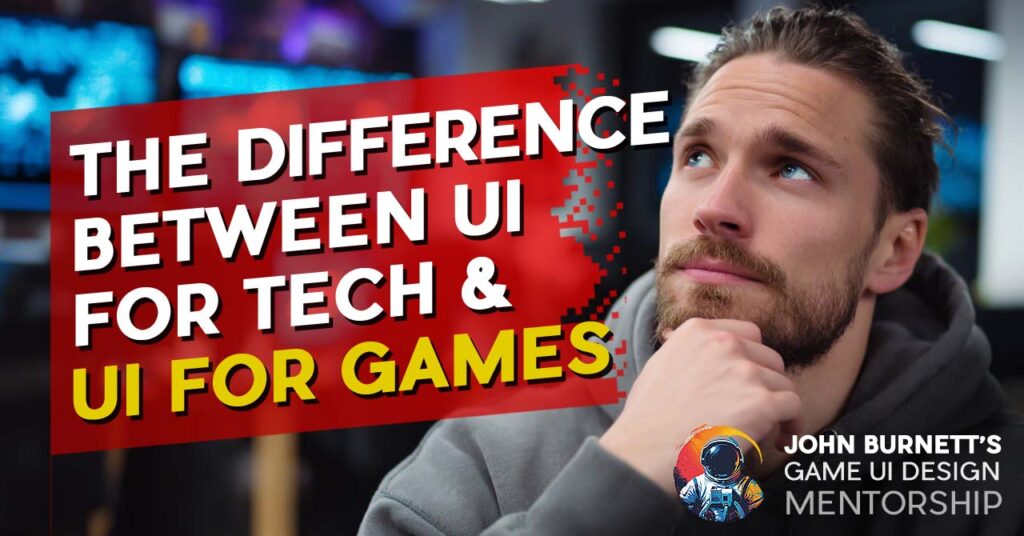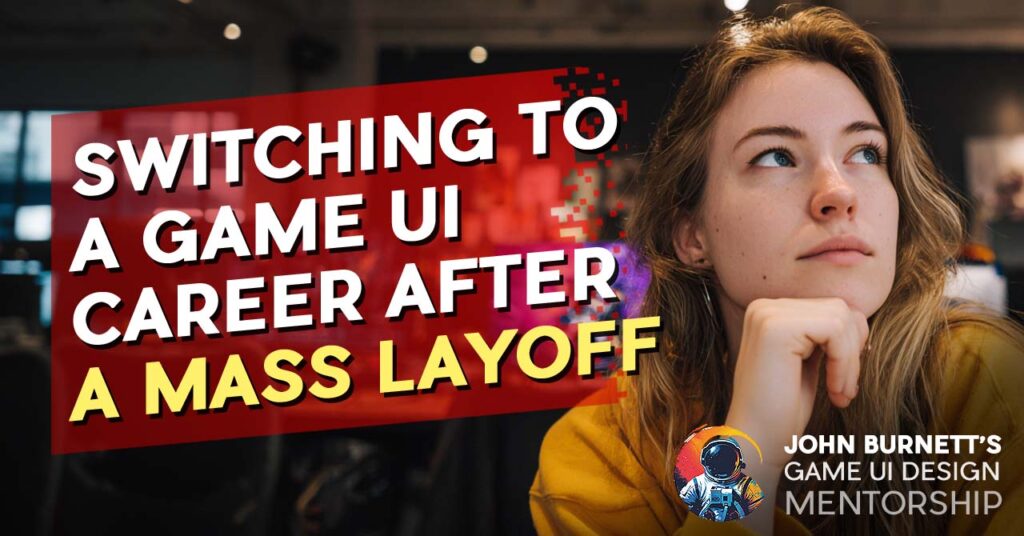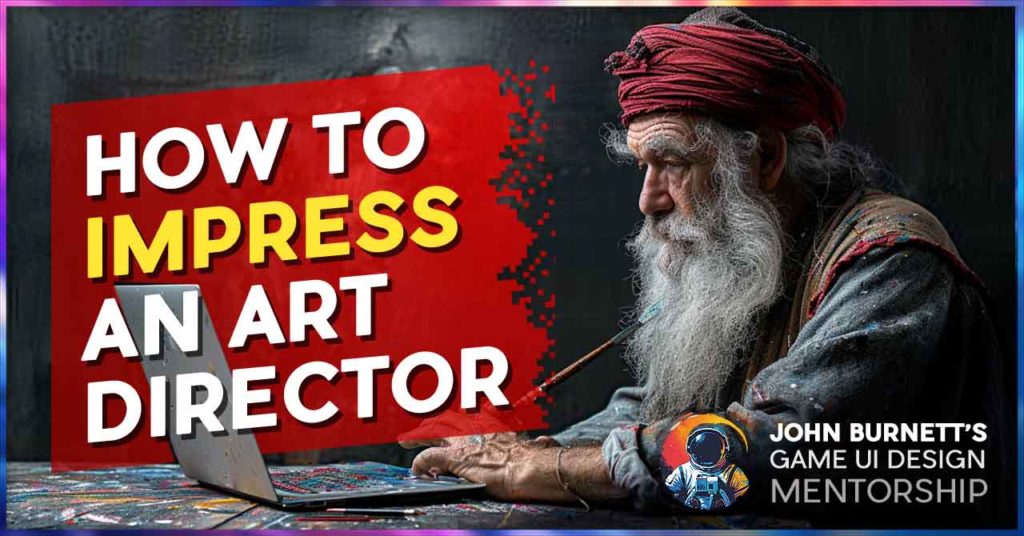The Difference Between UI for Games and UI for Tech
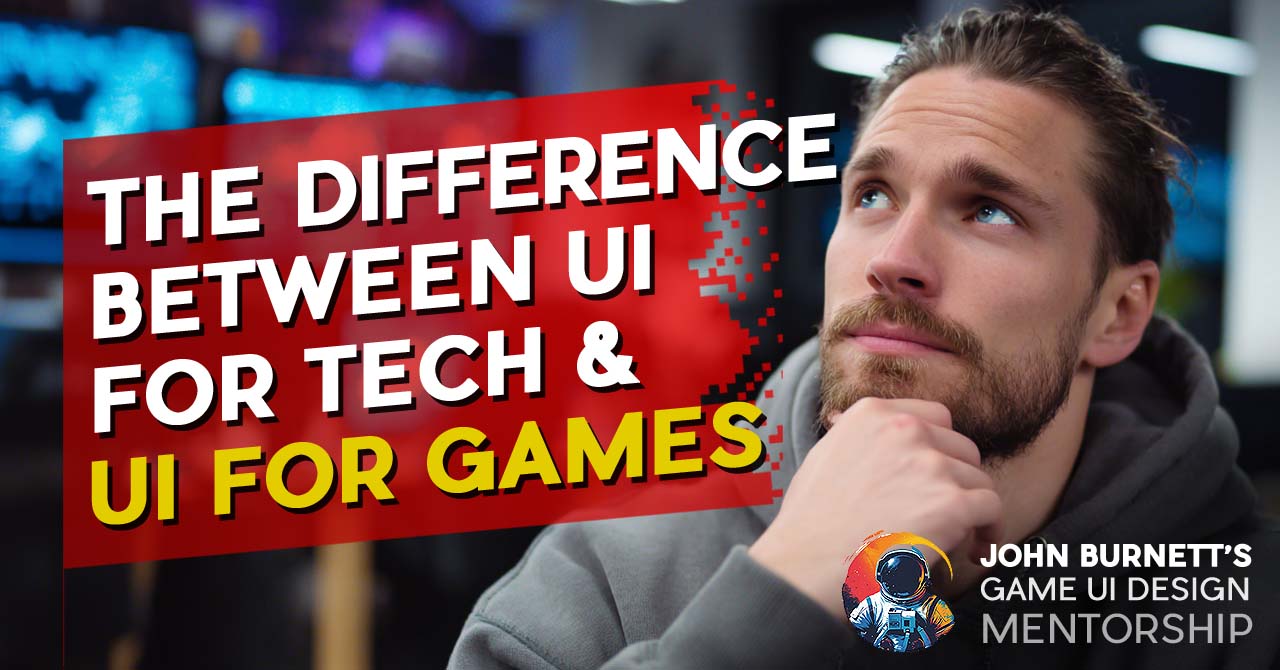
Game Design Course written by John “The Wingless” Burnett (LinkedIn)
Award-winning Senior UI Artist & Art Director in the Games & Entertainment Industry
former Midway Games, Electronic Arts, Id Software, Glu Mobile and more.

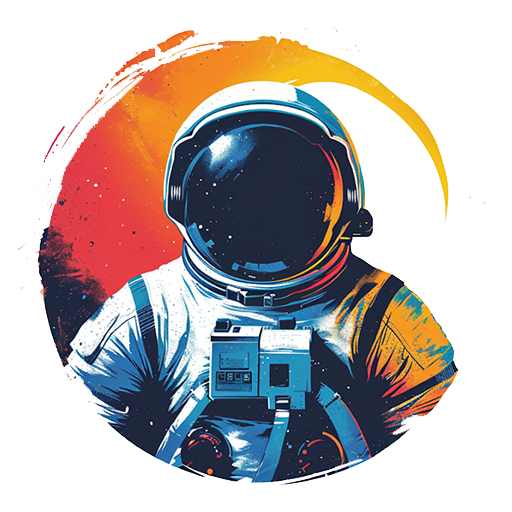
Want a real conversation instead of an article? Join my exclusive 1-on-1 Mentorship Program in Game UI Design and experience the world’s best private tech education 5 years running. Break into the Industry by leveraging your professional and creative skills with veteran leadership. Industry Certification and Buy Now Pay Later options available. Don’t let layoffs or regret define you, let’s build your future – today.

THE DIFFERENCE BETWEEN UI FOR GAMES AND UI FOR TECH
User Interface Game Design Course.
Tags: Tech UI, App Design, Web Design
INTRO
I mentor plenty of “refugees” from the App & Web Design world as they bravely make the career switch to Game UI Design. Invariably, the question comes up: so just what’s so different about Game UI versus Tech UI? Sometimes Mentees come perilously close to saying that classic Bond villain cliche, “We’re not so different, you and I…”
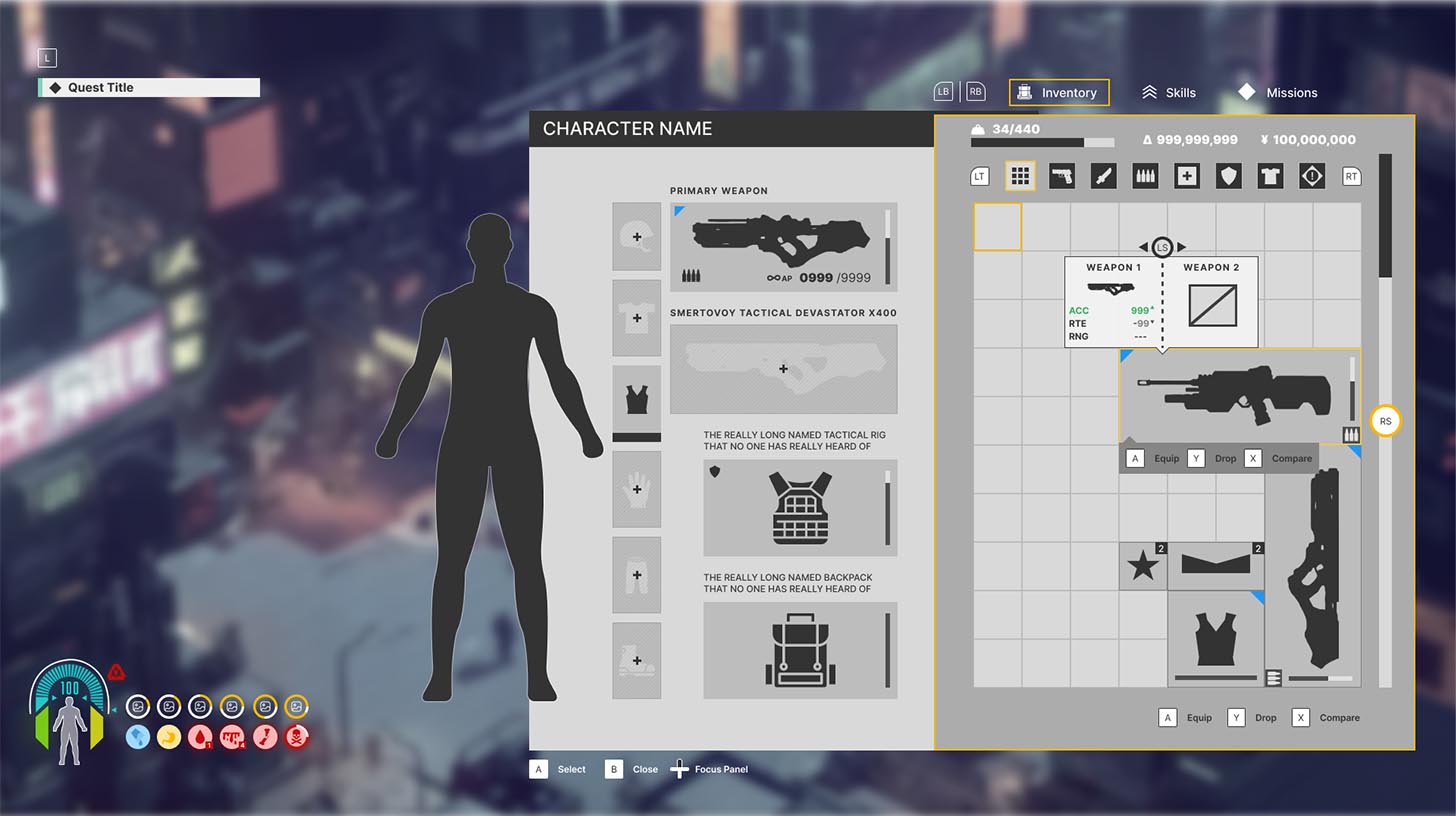
PART 1. THE BIGGEST DIFFERENCE: BALANCE
I can’t think of a single person who plays a game and shrieks, “This interface is just so clean and usable, Bro!”. And yet the idea of a Game, App or Website embarrassing itself with bad usability is a complete non-starter. For all three mediums, usability is key… but it might not necessarily be king in Games.
The same is true of aesthetics, which you might have assumed would now take priority. Not true – that same friend mentioned above might never notice the artistry of an interface even after a hundred hours of activity. So if it isn’t usability or aesthetics… What exactly separates Game UI from App or Web Design?
The answer is Balance; Game Interfaces balance aesthetics, functionality and emotion all at once. A simple color choice on a First Person Shooter HUD might look visually incongruous, be misread as shields instead of health, or obliquely add to the game’s difficulty. No app or website has to deal with anything close to that trifold balancing act – second by second.
UNIQUE ELEMENTS A UI ARTIST MUST BALANCE
Okay, so it’s all about Balance, but what does that mean exactly? Let’s get hyper-specific about what macro and miniscule concepts you’ll have to juggle and tweak as a UI Artist. Here is an exhaustive (?) list of rare information on just what UI elements a Game UI Artist has to balance:
- Screenspace versus airiness
- Widget grouping versus Widget spacing
- Color intensity versus leading the eye
- Innovation versus Genre Standards
- Bespoke solutions versus expected frameworks
- Customized screens versus templates
- Effects & Animation versus expediency
- Monochrome HUD versus full color
- Elaborate icon design versus minimalism
- Player immersion versus corporate interests
- Creative Director bias versus Public Opinion
- Internal barometer for quality versus Bosses’ judgement
- Maximalism versus sensory overwhelm
- Minimalism versus graphical starvation
.
WANT YOUR OWN 1-ON-1 MENTORSHIP IN GAME UI DESIGN?
TRUSTED LEADERSHIP . REAL EDUCATION . PERSONALIZED CLASSES . CERTIFICATION . EMPATHY
Don’t let lament or layoffs define you. Forge your own path with your real passion.
Join my exclusive one-on-one Mentorship program in Game UI Design for only $3997 (payments as low as $200/mo).
Seating is extremely limited to only 5 at a time.
Discover your future and register for free
.
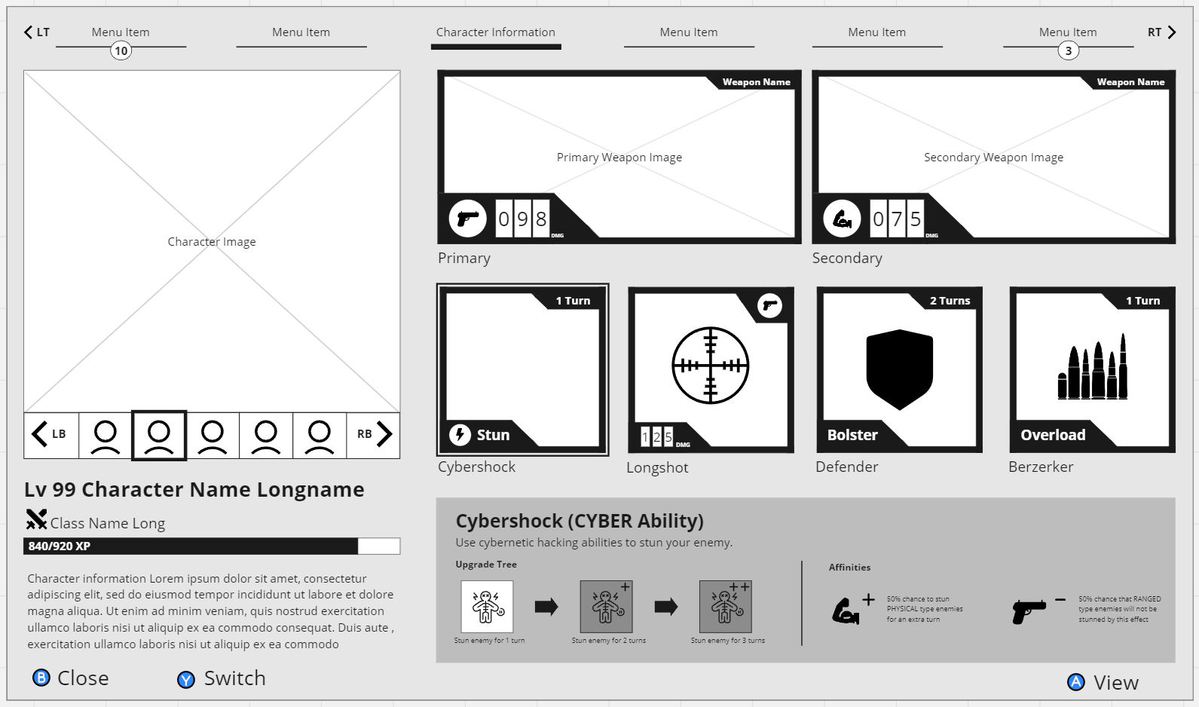
PART 2. A BIG DIFFERENCE: DESIGN BY GAME COMMITTEE.
“But John!” I hear you exclaim as you rise from your auditorium seat (rude), “Everything is designed by a committee!”. Sure, I’ll buy that – but Game Design has some of the most unique Stakeholders you’ll ever find in a Design-By-Committee…uh, Committee. I’ll playfully divide Stakeholders into two groups: Striketeam and Veto.
Your Striketeam (or Strikeforce, not as cool as it sounds) is a group pulled from various disciplines within the Studio to solve one specific problem – one of which is almost always UI. Your Striketeam will likely consist of a dedicated UI Engineer, a Designer, possibly another UI Artist, maybe the Art Director and depending on the intensity, a Producer. As peers, they provide opinions… which are treated like most opinions: noteworthy and not necessarily deserving of action.
Which then leads us to the complete tonal opposite group we’ll call Veto – so named because they have the Veto power on any idea, from anyone. Nominally, this is the Creative Director, whose subjective opinion overrides anyone else’s by necessity. But the Veto power can also come from such farflung orbits as the Parent Company, an expensive A/B test, or even a Founder’s partner at home! The Politics of being a UI Artist are often about sussin’ out just who is a peer and who has the almighty Veto power.
THE LIST OF GAME STAKEHOLDERS
Between your Striketeam and The Veto’ing powers that be, there’s quite the list of characters and classes you’ll be interacting with. Best to get the usual suspects in a tidy little row. Here is a definitive list of every kind of person you’ll likely interact with as a UI Artist.
- Game Creative Director
- Game Producer
- Game Associate Producer
- Game Art Director (though they may have little to say until the Art pass)
- UI Engineer (either their official title or a temp Strikeforce addition)
- Game Designer
- Another UI Artist or the UI Department (if contract or outsourcing)
- Marketing (rarely)
.
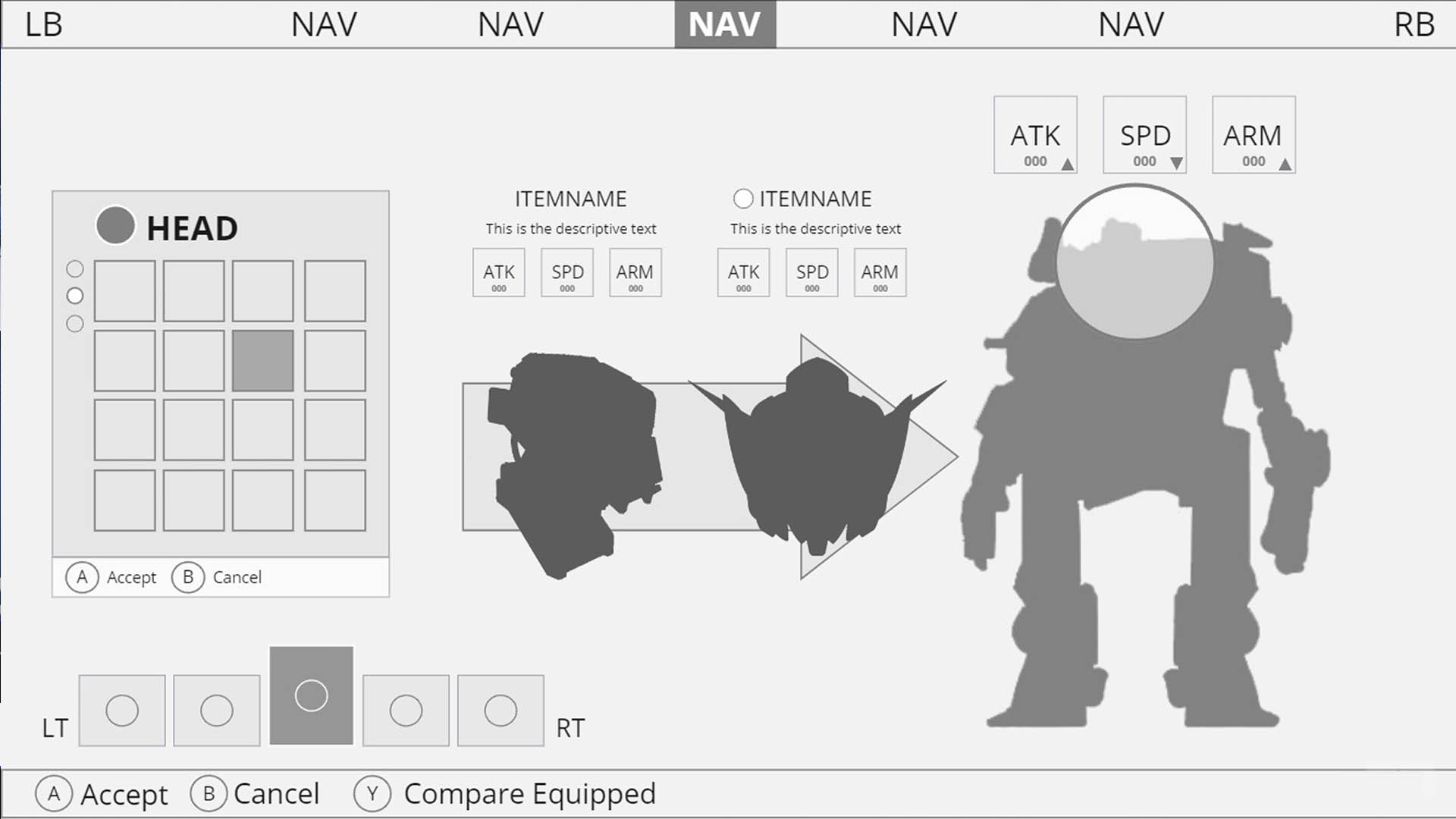
Part 3. ANOTHER DIFFERENCE, THE INFORMAL PROCESS.
One of the jokes I like to make in my Game UI Design Mentorship is that the Game Industry is way more Han Solo than it ever will be Captain Picard. Projects can go through tectonic shifts from a Game Convention, whole genres can dry up seemingly overnight, and are we switching Engines again? The traditional Design world is neat, orderly – downright elegant compared to the towering Rube Goldberg machine that is Game Design.
I believe the reason for this messiness is time. Obviously, every website and app has a release date, just like any Game. But Games are strategically released in order to avoid major releases, ride holiday trends, and not overshadow a company’s own releases (if the same company releases two RPGs at the same time, they’re cannibalizing their own base!). For us Gamedevs, Time, and by extension tardiness, is a killing word: the game will release – come Hell or highwater – and we’ll just have to patch it later.
Game production is also messy as a result of murky endpoints and an equally obscure execution. Apps and Websites have singular goals or familiar setups. By contrast, a Game has to be financially successful, emotionally resonant, technically feasible – all while reinventing the wheel time and time again (ever hear of a sequel?). A direct consequence of that reinvention is that a Game doesn’t really come together until the 90% mark. Before that milestone, every element is detached from a vision like a raw jigsaw puzzle – and we have to cobble it together last-minute because only now are the pieces mercifully forming an image.
UNIQUE TIME TRAPS IN GAME DESIGN PRODUCTION
We talked briefly about how production in Games is very messy. While any production is rarely on-time and on-budget, Games have a unique set of time-related challenges. Here is a definitive list of time disruptions to Game Production.
- Paradigm shifts in the Game’s Design in mid-stream
- Executive Leadership changes
- Executive Leadership exits (this is a red flag if they’re a Founder and it’s a new studio!)
- Company Buyout, merger or a new Parent Company
- Committing to slavishly to a genre
- Bailing quickly on a genre to move to a new trend
- Running out of funding or “runway”
- New funding, which demands a new direction
- Failing to pass the rigorous testing console developers demand
- Widespread refunds and delisting
- Bad press prior to a game’s release.

LET’S SUM UP
Yes, there is an obvious overlap in skills, goals and maybe even the day-to-day between a Game UI Designer and an App or Web Designer. But those similarities are largely superficial. Game UI Artists must strike a balance in all things, design for a remarkably specific committee, and roll with a somewhat laissez-faire attitude towards structure or scheduling.
- A Game UI Designer balances aesthetics, functionality and emotion all at once – moment by moment – while constantly reinventing the wheel.
- While most Design work is done with the approval of a committee, in Games you’ll have a wide scattering of Stakeholders that you can largely ignore (but you shouldn’t) and others that you are oathbound to execute upon (but you shouldn’t).
- Game Design is an organic and haphazard process that only gains clarity and cohesion near the tail-end
Related Links and Further Reading
.
MY LATEST FREE DESIGN COURSES.

JOIN JOHN BURNETT'S GAME UI DESIGN MENTORSHIP
Don’t let layoffs or regrets define you. Join my exclusive Game UI Design Mentorship program and break into the Game Industry by leveraging your current skills and creativity. With over 5 years of excellence and 50+ successful alumni, my Game UI Design Mentorship Program is the #1 private UI Design Mentorship in the world. Industry certification and Buy Now Pay Later options available. Let’s build your future – today.
JOIN JOHN BURNETT'S MIDJOURNEY Ai MASTERCLASS
Don’t let Ai replace you, let it embrace you. Learn Midjourney, the world’s #1 Ai Art Generator with your own private Art Director. Master the app in record time and generate stunning art that feels humanized and avoids “Ai Slop”. Receive Industry Certification and use our Buy Now Pay Later options. Your Future looks beautiful.
JOIN JOHN BURNETT'S CREATIVE STRATEGY
Are you suffering Creative Block or ready to create your Opus? Join my Creative Strategy and receive incredible insight, support and direction from an Industry leader in Creativity. Work on your projects with dedicated support, rain or shine, for months on end. Buy Now Pay Later options available. Take your Creativity to the next level.
GAME UI DESIGN LONGTAIL SEO SEARCH TERMS
This may seem tangentially related, but many of my Game UI Design Mentees are also web designers and have a passing knowledge of SEO. As one of the very few Gamedevs with his own long running site, search engine optimization for terms is at the heart of my business. Many of you won’t care, but some of you always ask (and it’s very obscure knowledge only a few of us know) so freely given: here are the SEO longtail search terms used to find this free Game UI Design Course.
- game UI design vs tech UI design
- difference between gaming UI and application UI
- why is game UI different from app UI
- game UI vs application UX
- user interface design for games vs software
- principles of game UI vs tech UI
- is game UI more complex than tech UI?
- tech UI designer vs game UI designer salary
- immersion vs efficiency in UI design
- game UI vs app UI animation styles
- visual feedback in game design vs tech design
- heads-up display vs dashboard UI
- Skeuomorphism vs flat design in UI
- stylized UI vs minimalist tech UI
- game UI sound design vs tech UI notifications
- the role of color in game UI vs tech UI
- game pause menu vs app settings menu
- in-game inventory management UI
- onboarding tutorials for games vs applications
- UI for in-game currency and rewards
- mobile game UI design vs mobile app UI design
- responsive UI for games on different devices
- error messages in games vs error messages in software
- player HUD design best practices
- persuasive design techniques in game UI
- how to gamify a tech application UI
- user motivation in game UI vs tech UI
- creating emotional connection through UI
- UX challenges in video games vs enterprise software
- player frustration in game UI design
- how to make tech UI feel more interactive

